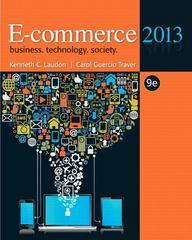Question
give brief summary 1. (a) (i) Define the economic terms: individual (firm) supply; market supply. (ii) Explain, with the aid of labelled diagrams, the relationship
give brief summary
1. (a) (i) Define the economic terms: individual (firm) supply; market supply.
(ii) Explain, with the aid of labelled diagrams, the relationship between individual
(firm) supply and market supply.
(b) Explain, with the aid of a labelled diagram, the supply curve of an individual firm in
each of the following circumstances. State one example in each case.
(i) A firm is willing to increase supply as price rises, but there is a minimum price below
which the firm will not supply at all.
(ii) A firm can supply only up to a maximum production capacity.
(iii) The product is fixed in supply (e.g. perishable good) and a firm is operating in the
short run.
(c) Outline FOUR factors, other than price, which affect the supply curve of an individual
firm. In each case explain how the factor affects the supply curve.
2. (a) (i) A firm operating under conditions of perfect competition is a 'price taker'. Explain
the concept of being a 'price taker'.
(ii) Explain, with the aid of a labelled diagram, the equilibrium position of a firm in
short run perfect competition.
(b) With the aid of a labelled diagram(s), explain the impact which the entry of new firms
would have on the market and on the equilibrium position of this firm.
(c) (i) Many firms today engage in product differentiation. Explain this underlined term showing,
with suitable examples, how it can be achieved.
(ii) Explain the effect of product differentiation on the AR and MR curves of a firm, which
previously operated under conditions of perfect competition.
3. (a) The demand for labour as a factor of production is a derived demand and is affected by
that factor's Marginal Revenue Productivity (MRP).
(i) Explain each of the underlined terms.
(ii) Outline TWO developments, other than a fall in MRP, which may result in a firm
reducing its number of employees.
(b) (i) State and explain THREE factors which are currently affecting the supply of labour
to the Irish economy.
(ii) The demand for labour has increased significantly in certain sectors of the Irish
economy in recent years, e.g. construction.
Discuss THREE economic consequences of this situation.
(c) 'At a time of full (or near full) employment in the Irish economy, it is important that there should
be the maximum occupational mobility and geographical mobility of labour.'
(i) Distinguish between the two underlined terms.
(ii) Outline THREE economic policies which could increase either occupational mobility of
labour or geographical mobility of labour, in Ireland.
Step by Step Solution
There are 3 Steps involved in it
Step: 1

Get Instant Access to Expert-Tailored Solutions
See step-by-step solutions with expert insights and AI powered tools for academic success
Step: 2

Step: 3

Ace Your Homework with AI
Get the answers you need in no time with our AI-driven, step-by-step assistance
Get Started


